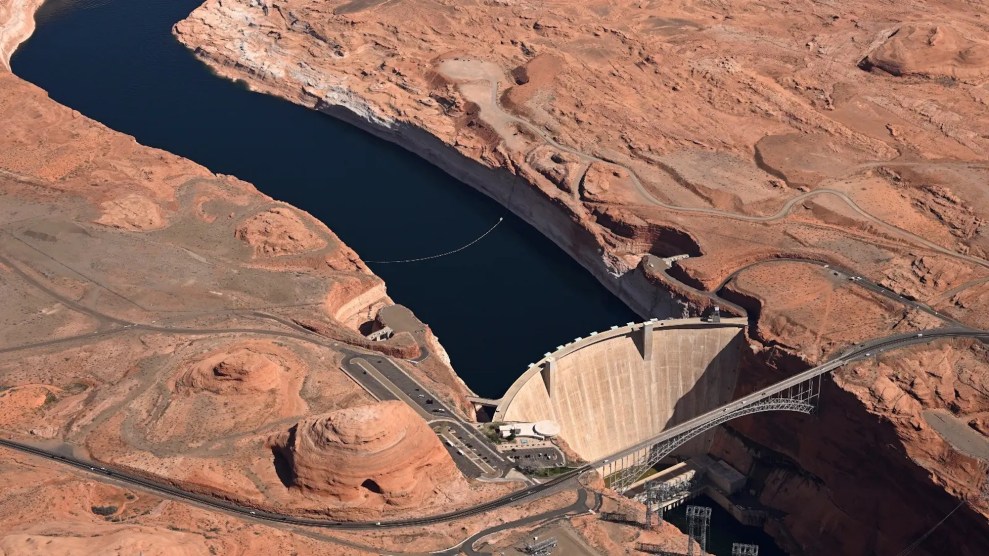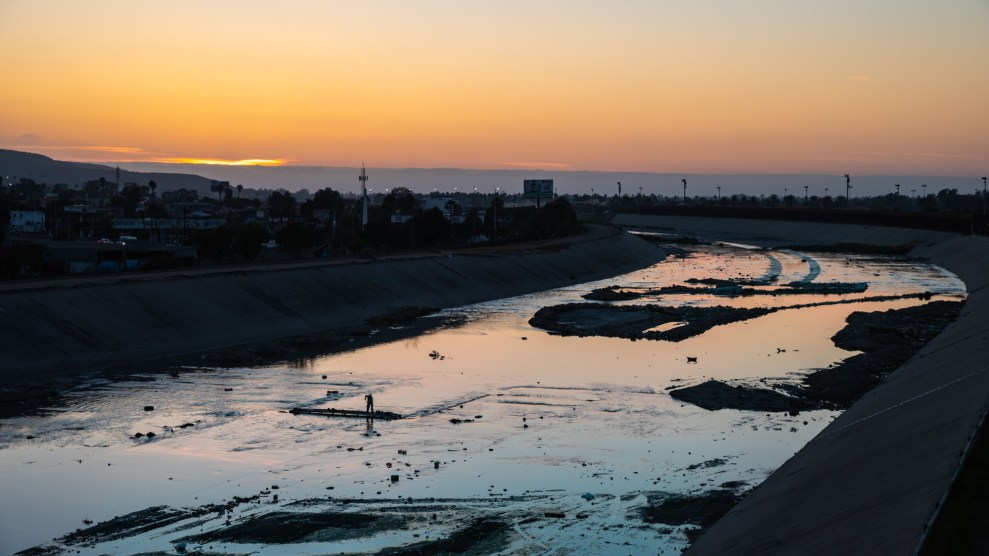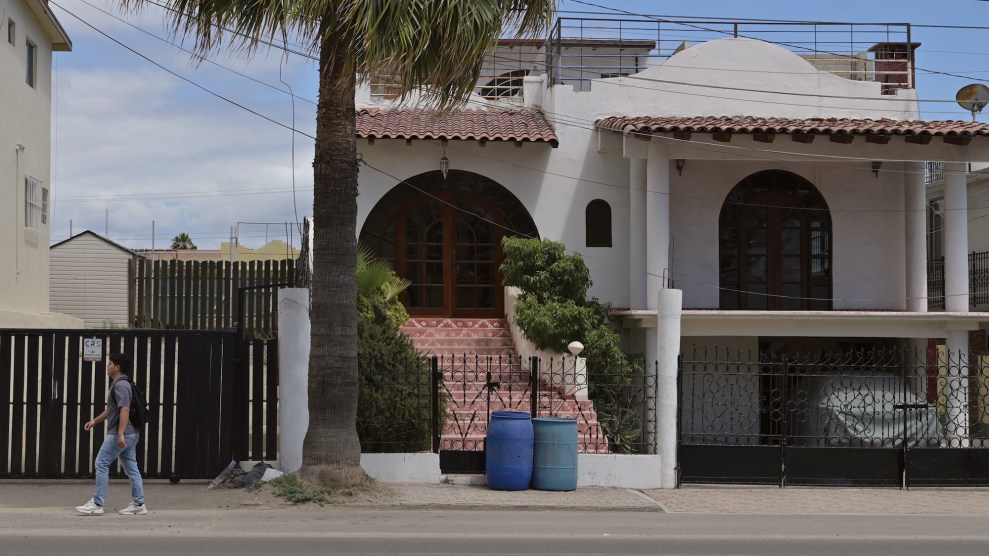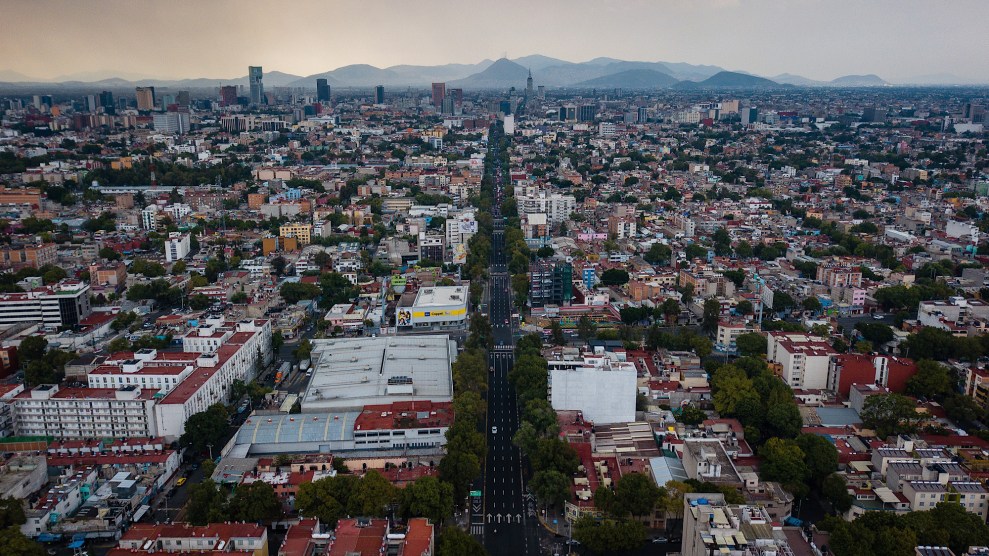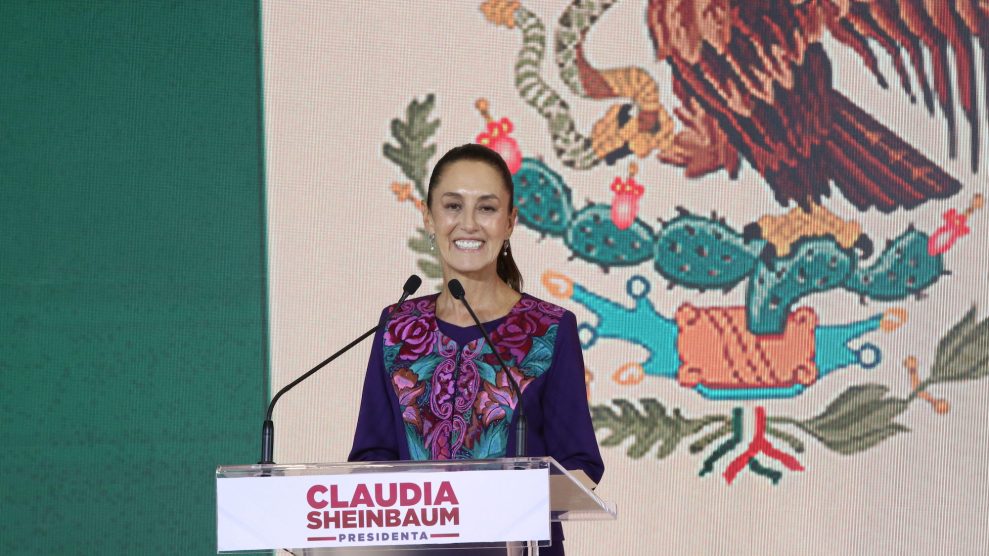
Claudia Sheinbaum announcing her win for president at a press conference. Jose Luis Torales/Zuma
This story was originally published by Inside Climate News and is reproduced here as part of the Climate Desk collaboration.
Mexico’s President-elect, Claudia Sheinbaum, an energy engineer and physicist by training, has published widely on the energy transition and greenhouse gas emissions as an environmental scientist. She has co-authored a UN climate report, and as Mexico City mayor, she installed solar power on a city market and electrified public transportation routes.
Now, the country waits to see whether her environmental pedigree will translate into action as president. Sheinbaum’s predecessor, outgoing President Andrés Manuel López Obrador, cut funding for environmental agencies and let Mexico’s international climate commitments languish. He backed more domestic oil production and the construction of a new refinery.
Sheinbaum remained his loyal ally; López Obrador paved the way for her to ascend to Mexico’s highest office. But on energy and climate issues, while his protegé strikes a different tone, she remains committed to continued use of fossil fuels.
Will Sheinbaum follow “the agenda she inherited from Andrés Manuel López Obrador” or “the agenda of a well-informed scientist”?
Sheinbaum’s campaign platform commits to the nation’s energy transition, electrifying transport and reducing Mexico’s greenhouse gas emissions. Yet she also supports a recently constructed oil refinery, natural gas pipelines and petrochemical plants.
She champions domestic oil production but is largely silent on natural gas, for which Mexico is highly dependent on the United States. Sheinbaum will have to thread the needle between continuing López Obrador’s legacy—leading the party he founded—and crafting her own political identity.
“Which side of her is going to win?” said Claudia Campero, a long-time environmental activist in Mexico City who works with the organization Conexiones Climáticas. “The agenda she inherited from Andrés Manuel López Obrador? Or the agenda of the well-informed scientist who understands the climate crisis perfectly?
“It’s still up in the air.”
Sheinbaum was born in Mexico City in 1962. Her Jewish grandparents fled Lithuania and Bulgaria. But she was raised in a secular household, more concerned with left-wing politics than religion.
She earned undergraduate, masters and doctorate degrees from the National Autonomous University of Mexico (UNAM) in energy engineering and physics. Sheinbaum also completed coursework at Stanford and the University of California, Berkeley, and worked as a researcher at the Lawrence Berkeley National Laboratory in the early 1990s.
Before ascending to the presidency six years ago, López Obrador was elected Mexico City mayor in 2000, representing the PRD party. He named Sheinbaum his secretary of the environment, a post she held until 2006.
Sheinbaum later continued her research at UNAM, including papers on electrical sector reform and carbon dioxide emissions and energy consumption in the Mexican industrial sector. She also authored contributions to the UN Intergovernmental Panel on Climate Change’s Fourth and Fifth Assessment Reports.
“Very little has been done to make progress” on Mexico’s climate change law’s goals.
In 2018, López Obrador ran for president representing the MORENA party he had founded after leaving the PRD. Sheinbaum ran for Mexico City mayor that same year with MORENA. They both won and worked together closely over the coming years.
As mayor, Sheinbaum led the electrification of much of the bus system and new cable-car routes were built. But she faced pushback for building a bridge through wetlands in the historic Xochimilco borough.
Campero, the advocate, pointed to a rainwater capture program in low-income neighborhoods as emblematic of Sheinbaum’s approach to environmental issues. The project had environmental benefits but prioritized improving quality of life in marginalized neighborhoods.
“She prioritizes social policy,” Campero said. “The environmental side is there, but the motive of economic growth has more weight in her decision making.”
López Obrador was elected president in his third run for the top office. He took office intent on undoing reforms, passed in 2013, that he thought undermined Mexico’s sovereignty by allowing increased foreign investment in the energy sector.
Some of López Obrador’s most contentious projects had vast environmental impacts: the Mayan Train across the biodiverse Yucatan Peninsula; a costly refinery at Dos Bocas; the Trans-Isthmus Corridor logistics route.
Despite López Obrador’s rhetoric of energy sovereignty, Mexico’s dependence on natural gas from the United States deepened during his administration. Northern Mexico’s proximity to the prolific oilfields of Texas, paired with the 2013 energy reforms, allowed a vast network of pipelines to expand across the border into Mexico.
By 2022, imports from the US provided 69 percent of Mexico’s natural gas, according to Mexico’s Secretary of Energy. In 2023, natural gas accounted for about 58 percent of Mexico’s electricity use. Even more pipelines have been proposed recently to transport natural gas from the US to Mexico’s coasts for liquefaction and re-export. In 2022, the US exported a record high $55.8 billion worth of petroleum products and natural gas to Mexico.
Mexico’s General Climate Change Law set a goal of 35 percent of electricity from clean energy sources by 2024. Progress toward this goal stalled during López Obrador’s administration. Renewables provided 23 percent of electricity in 2023, according to clean energy think tank Ember. The administration’s biggest investment in renewables was the 1,000-megawatt Puerto Peñasco solar farm in Sonora.
Mexico’s climate policy went backwards under López Obrador, according to Carlos Asúnsolo, director of public policy and research at the Mexican Center for Environmental Law (CEMDA). Mexico updated its Nationally Determined Contribution under the Paris Agreement in 2022 to reduce greenhouse gas emissions by 35 percent by 2030.
“Today, we know that very little has been done to make progress on these commitments,” Asúnsolo said.
The federal government has largely rejected CEMDA’s requests for documentation of progress toward these commitments. The organization Climate Action Tracker ranks Mexico’s progress on its targets as “critically insufficient.”
While López Obrador promoted the state oil company PEMEX, the firm’s emissions and pollution seemed to be an afterthought.
“The discussion of hydrocarbons [in Mexico] is who reaps the benefits,” Conexiones Climáticas’ Campero said. “There hasn’t been much discussion of environmental protection.”
PEMEX is one of the top 10 firms globally that have contributed to global carbon emissions, according to the Guardian. Mexico has also promised to reduce methane emissions by at least 30 percent by 2030 under the Global Methane Pledge. But satellites have repeatedly detected massive methane releases from PEMEX’s offshore platforms.
In a debate, Sheinbaum said Mexico will use renewable energy while “at same time having a foundation with [natural] gas.”
“[Mexico] has an above average, by far, methane emissions intensity,” said Diego Rivera Rivota, a senior research associate at Columbia University’s Center on Global Energy Policy. “It’s a massive challenge, one of the many challenges that PEMEX has in their list of challenges to be resolved.”
Meanwhile the impacts of climate change became ever more apparent in Mexico. Hurricane Otis barreled into Acapulco last year, killing 52 people. Warm ocean surface water likely caused the storm to intensify rapidly, catching forecasters off guard. Extreme heat this May pushed electricity demand to record high levels. Drought has diminished the water supplies for major cities, including Mexico City and Monterrey.
Some Mexican scientists bemoan what they call a “lost administration” to address the worst impacts of climate change. Nonetheless, López Obrador’s social and labor policies were wildly popular and lifted many Mexicans out of poverty. His promise to put the poor first resonated in a country with entrenched poverty. Coasting on high approval ratings, MORENA was poised to hold on to the presidency in 2024.
Sheinbaum’s main opponent in the presidential race was Xóchitl Gálvez, who represented a coalition of the PRI, PAN and PRD parties. Both Sheinbaum and Gálvez promoted renewable energy in their platforms, while Gálvez put a stronger emphasis on private investment.
By the time polling places began reporting on Sunday night, it was clear Sheinbaum had a commanding lead. She won almost 60 percent of the vote and several million more votes than López Obrador captured in 2018. MORENA also won a majority in both houses of congress. Sheinbaum will enter office on Oct. 1 for a six-year term.
Sheinbaum’s campaign platform states that energy policy will “redirect the sector toward an authentically sustainable future.” But Sheinbaum has also promised to “consolidate” the Dos Bocas refinery and increase domestic oil production. Throughout, Sheinbaum has emphasized central roles for PEMEX and the state electric utility CFE. Her platform also commits to engaging in the UN climate change Conference of the Parties.
Her energy sector plans include wind, solar, hydropower, green hydrogen and geothermal. In an event with business leaders, Sheinbaum proposed dedicating $13.6 billion to these new energy generation projects.
In a presidential debate, Sheinbaum said Mexico will use renewable energy while “at same time having a foundation with [natural] gas.” She also voiced support for a new gas pipeline to the Yucatan Peninsula.
“We have six years to do something significant to reduce greenhouse gas emissions and fulfill international climate commitments.”
While international media headlines celebrated Mexico’s first elected woman president and her environmental credentials, Mexico is expected to continue to rely on imports of US petroleum products and gas. Energy industry publications reassured their readers that Sheinbaum will “stay the course” and demand for Texas gas will “stay robust.”
Adrian Duhalt of Columbia University’s Center on Global Energy Policy expects Mexico to increase imports of US natural gas in the near term. Some of MORENA’s projects, like industrial parks planned in Southern Mexico, will require increased gas imports. In Northern Mexico, companies are relocating from Asia to be closer to the US market, a trend called near-shoring, which is also driving gas demand.
But Duhalt sees a path for Mexico to invest in renewables, storage capacity, batteries and energy efficiency to gradually reduce dependence on natural gas from the United States. Duhalt said Mexico’s state-owned energy companies could be important tools to help speed the energy transition.
Columbia’s Rivera Rivota said recent heat waves have emphasized the importance of shoring up Mexico’s electrical grid and diversifying power sources. Mexico had to implement rolling blackouts during a heat wave last month.
“The main driver of this is an increase in temperatures. Those are the effects of climate change on the demand side,” he said. “This trend is here to stay.”
Sheinbaum rode the wave of López Obrador’s popularity to secure a second presidential administration for the MORENA party, which is just a decade old. While climate change was a marginal issue for López Obrador, Sheinbaum could turn a new page.
Environmental advocates will be watching who Sheinbaum appoints to key cabinet positions like the Secretariat of Energy and the Secretariat of the Environment. They also say that budget allocations will prove whether her renewable energy ideas can be effectively implemented.
CEMDA’s Asúnsolo said Sheinbaum’s administration can make up for “errors and mistakes” of the outgoing president.
“We have six years to do something significant to reduce greenhouse gas emissions and fulfill international climate commitments,” he said. “I think this government still has time to do so. This is a very important moment.”

